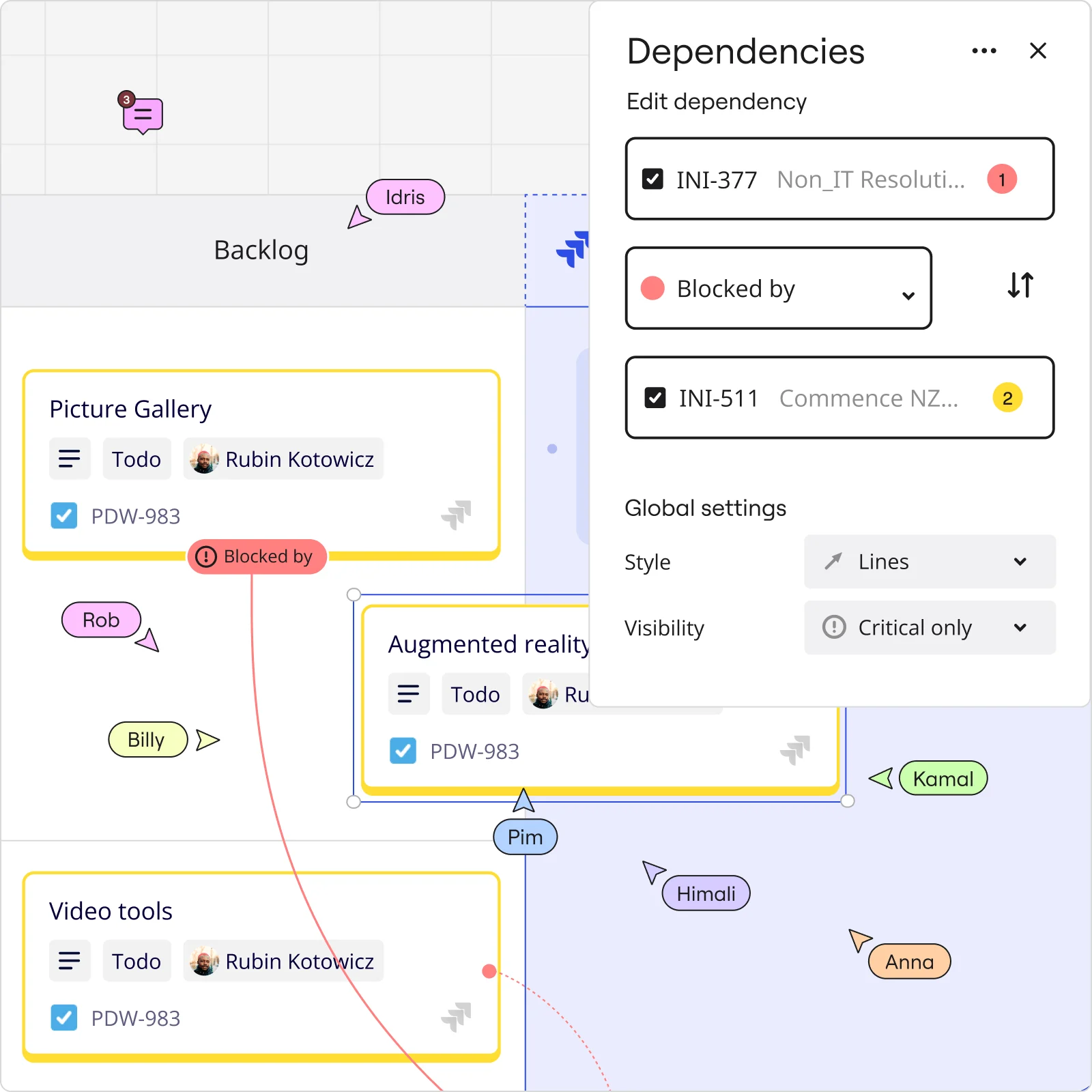
Table of contents
Table of contents
Dependency mapping

What is dependency mapping?
Dependency mapping involves creating visual representations, often in the form of maps or diagrams, that illustrate the relationships and dependencies between various components or elements within a system or project. Its primary purpose is to enhance understanding by providing a clear visualization of how different parts of a system rely on one another.
Try Miro now
Leverage Miro's tools for seamless project management and collaboration.
This can help project managers, developers, and other stakeholders make informed decisions, manage risks, and ensure that projects or systems are developed and operated efficiently. Various project management tools and techniques, such as dependency diagrams, Gantt charts, and network diagrams, are often used to represent these dependencies visually.

Key elements of a dependency map
A dependency map typically includes elements that help visualize and understand the relationships and dependencies within a system or project. The specific elements may vary depending on the context, but here are some common components found in a dependency map:
Nodes/Elements
These are the individual components, tasks, or entities within the system or project. Each node represents a distinct element that is part of the overall structure.
Arrows/Edges
Arrows or edges connect nodes to represent the dependencies between them. The direction of the arrow usually indicates the direction of the dependency, such as which task or component is dependent on another.
Dependency types
Different types of dependencies may exist, and these can be annotated on the arrows. For example, dependencies may be categorized as:
Finish-to-Start (FS): The dependent task cannot start until the task it depends on is finished.
Start-to-Start (SS): The dependent task can start when the task it depends on starts.
Finish-to-Finish (FF): The dependent task can finish when the task it depends on finishes.
Start-to-Finish (SF): The dependent task can finish when the task it depends on starts.
Dependency strength or weight
Some dependencies may have a stronger impact than others. Adding a weight or strength factor to the arrows can indicate the degree of influence or importance of each dependency.
Labels and descriptions
Nodes and arrows may have labels or descriptions to provide additional information about the elements or the nature of the dependencies. This can include task names, component details, or any relevant information.
Timeline or sequence information
In project management contexts, a dependency map might include a timeline or sequence information. This helps in understanding the chronological order in which tasks or components need to be completed.
Applications of dependency mapping
The types of dependencies being depicted can vary based on the context of various fields in which they can be used, such as:
Dependency mapping in Agile
Agile teams use dependency mapping to focus on iterative development and cross-functional collaboration. By mapping out dependencies between user stories, tasks, and team members, Agile teams can better understand the flow of work, identify dependencies that might impact project velocity, and plan sprints more effectively.
Dependency map in project management and planning
Dependency mapping plays a crucial role in project management by identifying critical dependencies between tasks, resources, and milestones. By visually mapping out these dependencies, project managers can effectively plan project timelines, allocate resources, and mitigate risks associated with interdependencies.
Dependency mapping in IT infrastructure
In the realm of IT, dependency mapping helps organizations gain insights into the complex relationships between hardware, software, and network components. It enables IT professionals to understand dependencies, troubleshoot issues, and optimize system performance by identifying bottlenecks and areas of potential vulnerability.
Dependency mapping in risk assessment
Dependency mapping is an invaluable tool in risk assessment and management. By visualizing dependencies, organizations can identify critical points of failure, assess the potential impact of disruptions, and develop contingency plans to mitigate risks.
Benefits of dependency mapping
Dependency mapping can lead to improved collaboration and better decision-making. Here are some key advantages:
Enhanced visibility and understanding
Dependency mapping provides a clear and visual representation of complex relationships, allowing stakeholders to gain a deeper understanding of dependencies within a system. This enhanced visibility facilitates more effective decision-making and problem-solving.
Improved decision-making
By considering the dependencies illustrated in a dependency map, organizations can make more informed decisions. Understanding the potential impact of changes or disruptions on interconnected elements enables better risk assessment and helps organizations choose appropriate courses of action.
Efficient resource allocation
Dependency mapping enables organizations to identify critical dependencies and allocate resources more efficiently. By understanding which components or tasks rely on others, organizations can allocate resources based on these interdependencies, ensuring optimal resource utilization.
Effective risk management
Visualizing dependencies through dependency mapping allows organizations to identify critical points of failure and potential vulnerabilities. This knowledge enables proactive risk management, allowing organizations to develop strategies to mitigate risks and safeguard against potential disruptions.